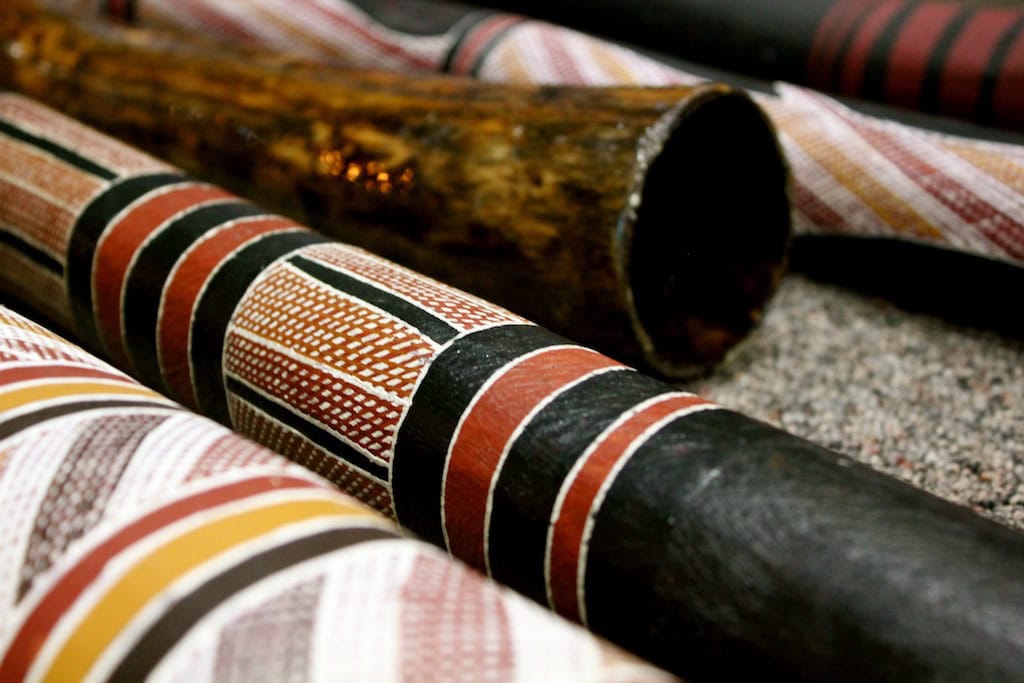The Didjeridu of Australia
The didjeridu (or didgeridoo) is a deceptively simple instrument in construction. Nevertheless, it can produce extremely complex music in the hands of an expert player. It is simply a tube with no reed, finger holes or moving parts of any kind. The player creates rhythm and shifts of timbre and pitch with movement of the breath, lips, tongue, cheeks, throat, vocal cords, and stomach muscles. “Circular breathing” is employed to produce continuous sound, whether a simple drone or an intricate rhythm.
A rough map of the origins of the didjeridu.
Aboriginal people of northern Australia invented the instrument and still use it in ceremonial and daily life today. Didjeridu is not in fact an Aboriginal term, but an onomatopoeic word created by European settlers describing the sound produced by traditional players. There are many words for the instrument in Aboriginal languages. The best known around the world are yidaki from northeast Arnhem Land and mago from west Arnhem Land. In both regions, it is also common to hear the word bambu used. Bamboo was occasionally in use at the time of European contact, but has now fallen out of favor with Aboriginal players.
Djalu Gurruwiwi begins chopping down a stringybark tree (Eucalyptus tetradonta) to craft a didjeridu.
These days, people around the world make didjeridus out of a wide variety of materials. Traditionally, however, instruments are made from trunks of eucalyptus trees that have been hollowed out by termites commonly known as “white ants.” A craftsman scans a forest for likely instruments, then taps a tree up and down to evaluate the hollow inside. If it sounds good, the tree is felled, cut to length, stripped of its bark and carved down to match the interior hollow.
If the natural hollow of the wood at the top is too big or irregularly shaped, a material found in bee nests called “sugarbag” is formed into a mouthpiece. Sugarbag is a black, gummy substance native Australian bees make by mixing their wax with eucalyptus tree resin, not the yellow wax of European bees that is often seen on instruments made for the tourist market. Instruments made for sale or special ceremonies may be elaborately decorated with clan designs related to the artist, but most didgeridoos in everyday use in northern Australia are unpainted or wrapped top to bottom in duct or electrical tape to hold them together through inevitable cracking as the wood dries.
Milkay Mununggurr accompanies ceremonial song with a didjeridu completely wrapped in tape.
Traditional Aboriginal players continue to use age-old tonguing techniques that stem from their language and are foreign to most outsiders. As the instrument has spread globally, many more styles have developed around the world, from new age drones to beatboxing, in both solo and ensemble settings.
Witiyana Marika and Milkayngu Mununggurr of Yothu Yindi perform a
traditional Yolngu song with didjeridu
Randin Graves plays contemporary didjeridu music with guitar
— Randin Graves is a composer, multi-instrumentalist, and one of the world’s leading non-Aboriginal exponents of the Australian didjeridu.
For more information on the didjeridu at its origin, visit YidakiStory.com, which Randin created in collaboration with many Yolngu Aboriginal people as part of his Fulbright Fellowship and Master’s Degree project.
